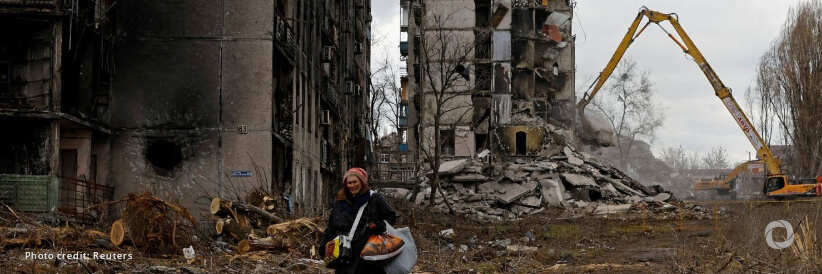In light of the devastating consequences of Russia’s war of aggression on Ukraine’s people, economy, and infrastructure, and given the enormous scale and complexity of the recovery and reconstruction challenge, the European Commission is proposing to establish a dedicated financing instrument that will provide coherent, predictable as well as flexible support for the period 2024-2027 to Ukraine, adapted to the unprecedented challenges of supporting a country at war.
The Facility underscores the EU’s steadfast commitment to supporting Ukraine in the face of Russia’s ongoing war of aggression and on its path toward EU membership.
Ursula von der Leyen, President of the European Commission, said: “Ukraine is bravely fighting Russia’s invasion and needs our stable financial support to face the tremendous costs this entails. The EU has promised to stand by its side as long as it takes and we are true to our word. Today we are proposing to foresee up to €50 billion from 2024 to 2027 to help Ukraine resist the aggression and rebuild a modern, prosperous country. Ukrainians are resolutely striving towards Europe. And our Union is supporting this brave nation in its effort.”
The new Ukraine Facility will support Ukraine’s efforts to sustain macro-financial stability, promote recovery as well as modernize the country whilst implementing key reforms on its EU accession track. It will support the transition towards a green, digital, and inclusive economy that is progressively aligned with EU rules and standards.
The Facility is organized around three pillars:
- Pillar I – financial support to the State in the form of grants and loans. This will ensure stable and predictable funding, supporting the sustainability of Ukraine’s finances, while providing a solid framework for the protection of the EU budget. To access this support, the Government of Ukraine will need to prepare a Plan for the recovery, reconstruction, and modernization of the country and detail the reforms and investments it intends to undertake as part of its EU accession process. Funds under this Pillar of the Facility will be provided based on the implementation of the Plan, which will be underpinned by a set of conditions and a timeline for disbursements agreed with the EU. Significant emphasis will be placed on public administration reform, good governance, the rule of law, anti-corruption, and sound financial management.
- Pillar II – a specific Ukraine Investment Framework designed to attract and mobilize public and private investments for Ukraine’s recovery and reconstruction, in support of the Plan’s implementation. It will complement all existing instruments supporting Ukraine, such as blending and guarantees, with the possibility of scaling up when conditions allow for it.
- Pillar III – technical assistance and other supporting measures, including mobilization of expertise on reforms, support to municipalities, civil society, and other forms of bilateral assistance normally available for pre-accession countries under the Instrument for Pre-Accession (IPA), also supporting the objectives of the Ukraine Plan. Under this pillar, it will also be possible to support other initiatives aimed at responding to the Russian aggression against Ukraine, including enforcing international law in relation to crimes committed by Russia on the territory of Ukraine. Interest rate subsidies for the cost of loans will also be covered under this pillar.
The foreseen overall amount of the Facility is up to €50 billion for the period 2024 to 2027 for both grants and loans. Grants will be mobilized through a new special instrument, proposed in the context of the Multiannual Financial Framework (MFF) mid-term review. The loans will be guaranteed through the headroom, similar to the current financing under the Macro-Financial Assistance ‘Plus’ (MFA+). The headroom is the difference between the own resources ceiling (i.e. the maximum amount of resources that the Commission can ask Member States to contribute in a given year) and the funds that the Commission actually needs to cover the expenses foreseen by the budget. The Facility also opens the possibility to use contributions from other donors as well as revenue generated by frozen and immobilized Russian assets as a contribution to Ukraine’s recovery and reconstruction. Work is ongoing on the possible use of Russian assets for Ukraine’s recovery and reconstruction.
The Facility and its implementation will be equipped with a robust framework for transparency, audit, and control, to ensure the protection of EU financial interests. First, the audit and control systems of the Ukrainian State are to be substantially enhanced as part of the reforms under the Plan. Second, the Commission will be able to carry out checks on projects in relation to the implementation of the Plan at any moment of the project cycle. Third a dedicated independent Audit Board will assist the Commission by regularly reporting on the implementation of the funds spent to achieve the objectives of the Facility, and by issuing recommendations to Ukraine.
Next steps
It is for the European Parliament and the Council to examine the proposal, in the framework of the MFF mid-term review package. Once adopted, Ukraine will be invited to submit its Plan, laying out the reforms and investments it intends to undertake. Following its assessment of the Plan, the Commission will make a proposal to the Council to adopt the Plan and set the conditions to be fulfilled by Ukraine to access support under the Facility.
See also: 🔴 LIVE UPDATES | Humanitarian response to Ukraine crisis

